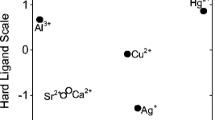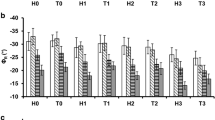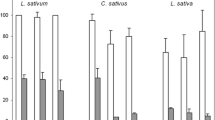Summary
Open-ended paraffin-coated and uncoated pyrex glass tubes with diameters ranging from 1.3 to 4.0 mm were suspended in toxic solutions. Corn roots were inserted into the tubes and allowed to grow for twenty-three hours in the dark. The use of 3 me Li+/l as Li2SO4.H2O as the toxic growth solution resulted in a root growth difference between the glass and paraffin-coated tube that could be ascribed to the surface type. The growth difference was significant at the 5% level in the two smallest tubes.
The use of a higher growth temperature, greater transpiration by the seedlings and vibration appeared to implicate ordered water in the interfacial region between root and tube surface as affecting ion mobility.
Similar content being viewed by others
References
Asinger, F., Paraffins, Chemistry and Technology. Pergamon Press, New York, N.Y. (1968).
Drost-Hansen, W., The effects on biologic systems of higher-order phase transitions in water. Ann. New York Acad. Sci.125, 471–501 (1965).
Duncan, W. G. and Ohlrogge, A. J., Principles of nutrient uptake from fertilizer bands; II. Root development in the band. Agron. J.50, 605–608 (1958).
Fedyakin, N. N., The change of the water structure on condensing in capillaries. (In Russian) Kolloidon Zh.24, 497–501.In Chem. abstracts.57, 14452F (1962).
Hosler, C. L. and Hosler, C. R., An investigation of the freezing of water in capillaries. Trans. Am. Geophysical Union36, 126–132 (1955).
Isaw, V. S., Potential conductivity of clays of different deposits. Tr. Mosk. Energ. Inst.48, 85–96.In Chem. Abstracts 61:68e (1964).
Kemper, W. D., Water and ion movement in thin films as influenced by the electrostatic charge and diffuse layer of cations associated with clay mineral surfaces. Soil Sci. Soc. Am. Proc.24, 10–16 (1960).
Low, P. F., Effect of quasi-crystalline water on rate processes involved in plant nutrition. Soil Sci.93, 6–15 (1962).
Miller, E. C., Plant Physiology. McGraw-Hill Book Co. New York, N.Y. (1938).
Miller, R. J. and Davey, C. B., The apparent effect of water structure on K-uptake by plants. Soil Sci. Soc. Am. Proc.31, 286–287 (1967).
Parowax Corporation, Personal Communication.
Robertson, J. A., Investigations of the influence of glass capillaries, immersed in toxic solution, upon root growth. Diss. Abs.24 (12), 4887–4888 (1964).
Author information
Authors and Affiliations
Additional information
Journal Paper No. 3374 Purdue Univ. Agr. Exp. Sta. Lafayette, Indiana. Contribution from the Dept. of Agronomy. A part of the Doctorate thesis of E.A.
Rights and permissions
About this article
Cite this article
Albregts, E., Ohlrogge, A.J. The role of tube diameter and surface characteristics in the tolerance of roots to toxic solutions. Plant Soil 33, 235–243 (1970). https://doi.org/10.1007/BF01378213
Received:
Issue Date:
DOI: https://doi.org/10.1007/BF01378213




